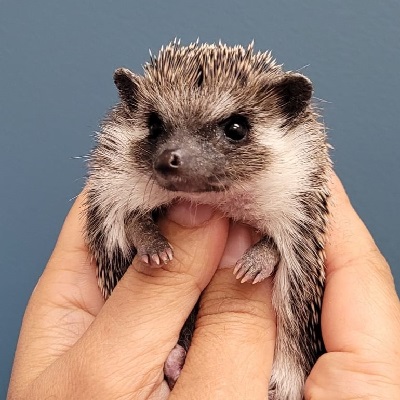
April showers may bring May flowers, but April also brought us fun facts about the hedgehog all month long! And now that the month is winding down, we need to bid the hedgehog a fond farewell so we can make way for May’s featured creature. We hope you enjoyed following us on @ExoticPetVets as we tweeted about hedgehogs throughout the month. But if you missed any of our tweets, you can reference the following summary. Did you know?:
- You may be surprised to hear that hedgehogs are one of the oldest mammals on the planet and have been on Earth long before humans.
- The earliest ancestor of the hedgehog first evolved about 15 million years ago during the Miocene epoch. By comparison, research suggests the earliest known human ancestors (Ardipithecus ramidus) evolved approximately 4.4 million years ago.
- Today there are 17 hedgehog species; including the Egyptian long-eared hedgehog, Amur hedgehog and European hedgehog.
- The most common hedgehog species kept in captivity is the African pygmy hedgehog (Atelerix albiventris), which is the species we are going to mostly focus on this month.
- Wild hedgehogs are endemic to parts of Africa, Europe and Asia. There is also an introduced population in New Zealand where they are an invasive species.
- The African pygmy hedgehog is found across a wide swath of central sub-Saharan Africa stretching from the west to east coast.
- Hedgehogs are highly adaptable and in the wild can be found in a variety of environments; including woodlands, grasslands, meadows, deserts, semi-desert habitats and agricultural areas.
- Hedgehogs have also adapted well to living in urban areas, where they typically settle in city parks and gardens.
- African pygmy hedgehogs are small mammals, measuring between 6-8 inches (15-20 cms) in average length when fully grown. Females tend to be a bit larger than males, but not in all cases.
- African pygmy hedgehogs have short limbs so they are low to the ground. Their backs are covered with approximately 6,000 quills and they have tiny tails.
- Did you know that the African pygmy hedgehog is also commonly known as the four-toed hedgehog? That’s because while they have five toes on their front feet, they only have four toes on their hind feet.
- The African pygmy hedgehog has another common name – the white-bellied hedgehog. That’s because they have greyish-white hair on their bellies.
- African pygmy hedgehogs also have greyish-white hair on their faces. Their snouts are long and a pinkish-brown colour. They have small dark eyes and short ears.
- Due to selective captive breeding, African pygmy hedgehogs can vary in their colouring and come in a variety of different morphs; including apricot, salt and pepper, cinnamon, chocolate chip, silver and dark cinnicot.
- Hedgehog quills (sometimes called spines) are short, sharp and are made up of keratin, which is the same fibrous protein that makes up our hair and nails.
- When they feel threatened, hedgehogs will protect their faces, bellies and legs by curling up into a spiky ball.
- Hedgehogs have a muscle called the panniculus, which has a thick rim that forms another muscle called the orbicularis.
- The orbicularis muscle is like a drawstring for hedgehogs that they can cinch to protect the vulnerable parts of their bodies as they curl up into a ball.
- To ward off danger as they are curled up, hedgehogs will jerk their bodies upward to thrust their quills into whatever is threatening them. Unlike porcupines, they don’t lose their quills.
- When they are agitated, hedgehogs will loudly hiss and make coughing or huffing noises. If they are in a state of severe distress, they may scream.
- Predators of wild African pygmy hedgehogs include carnivores such as badgers and wild dogs, large birds of prey and humans.
- Male hedgehogs are called boars, female hedgehogs are known as sows and baby hedgehogs are known as hoglets.
- They both have prickly appearances, but did you know that hedgehogs have something else in common with sea urchins? It has to do with their respective names.
- The Middle English word for hedgehog is “urchin” and sea urchins were actually once known as “sea hedgehogs.” While baby hedgehogs are commonly called hoglets, they are also still known as urchins.
- Hedgehogs engage in a strange behaviour known as “anting” or “self-anointing,” which – put another way – means they spit on themselves.
- Hedgehogs will “self-anoint” by putting objects that have strong odours in their mouths and mixing them with saliva. They will then move their heads about and coat their backs with the foamy saliva.
- Why do hedgehogs “self-anoint?” No one really knows for sure, but there are several theories. Some suggest they use the frothy saliva for camouflage or scent-marking.
- Hedgehogs are often considered insectivores and while they mostly eat invertebrates, they are actually omnivores and have a varied diet.
- In addition to worms, snails, slugs, insects and spiders, hedgehogs will eat fruit, vegetables, roots, carrion, frogs and small reptiles.
- Hedgehogs are resistant to toxins produced by some other animals and can eat small poisonous snakes and scorpions with no risk of illness or death.
This is the third time we have highlighted hedgehogs as our Animal of the Month. Check out our previous blog posts from June 2019 and September 2015 to see our tweets from the first two times hedgehogs were our featured creature!

